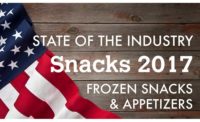Carefully considered products all have a sweet spot, that central nexus where everything comes together for a strong hit into the outfield—and for particularly astute product-development teams, the occasional home run.
Overview | Bread | Tortillas | Sweet Goods | Snack Cakes | Pizza | Desserts | Cookies | Buns & Rolls | Bars | Breakfast Products
The process often starts with identifying the needs and desires of a core group of consumers—or better yet, various demographics with widely reaching, overlapping or interrelated interests. Then it’s time to dial down into specifics.
It’s having the right equipment on the line to deliver top product attributes. It’s finding the right competitive price point through efficient, streamlined operations and strong throughput. It’s targeted ingredient selection. It’s crumb structure, taste, texture, shelf life, sensory appeal and overall eating enjoyment. It’s meeting target nutritionals and regulatory aspects. And increasingly, it’s hitting select better-for-you, health-and-wellness metrics.
It’s also selecting the right packaging format suited to maximized product protection and shelf life—and minimized capital expenditure and environmental footprint. For retail, it’s developing the right on-pack graphics, messaging and marketing, including the right merchandising mix.
In foodservice, it’s alignment with operational aspects like consistently meeting tight product specifications, aligning with total food cost restrictions, menu versatility, overall daypart appeal and whether or not the item is suited to an independent or chain restaurant.
Of course, not all of these dynamics factor into every bakery R&D project, and each might find a different level of weighted priority depending on the given situation.
But every new product launch means stepping up to the plate and taking a cut. And magic doesn’t always happen. But when it does, there’s nothing like the elation of finding that elusive sweet spot on the bat and sending the ball deep.
Harnessing trend physics
The physics of finding the sweet spot for any given product often involves determining how current trends, shopper/consumer desires and other factors will play into the mix.
“Clearly, the biggest trends are toward cleaner labels, health-and-wellness claims, artisanal products and frozen finished products,” says Robb MacKie, president and CEO, American Bakers Association, Washington, D.C. “They are all interrelated in some ways, and clearly designed to match up with changing consumer tastes and attitudes.”
Clean label continues to grow more mainstream. “Over half of the population (54 percent) rate ‘a clean label’ as an important attribute toward their food and beverage purchase,” says Steve Williams, vice president, strategic consulting, NMI, Harleysville, PA. “Consumers most devoted to a healthy lifestyle are significantly more likely than all other groups, and millennials are significantly more likely than all older generations to rate it as an important aspect of their food/ beverage decision.”
Clean label is also increasingly expanding into foodservice. McDonald’s reformulated its buns to remove high-fructose corn syrup. Panera introduced comprehensive clean-label initiatives, and Dunkin’ Donuts has made a commitment to reformulate its menu to remove all synthetic colors before the end of 2018.
“Younger consumers, especially millennials, are more likely to seek out products that have specific health claims,” says Williams. “Consideration of consumer desires requires a careful understanding of what tradeoffs they are willing to make with respect to healthy vs. unhealthy ingredients, artificial vs. natural sweeteners, indulgence vs. healthy nutrition, and especially premium positioning based on the most-important health claims. Regarding sweeteners, more U.S. consumers for the first time indicated in 2016 that they use honey as a sweetener ahead of refined/table sugar.”
Some better-for-you steps come easy for bakery. MacKie notes that the industry is often well positioned to capitalize on health-and-wellness claims. “They play to the industry’s strengths in terms of fiber, folic acid and other good-for-you attributes,” he says.
However, some trends are negatively impacting nutrition. “A big concern is the lack of consumer awareness around the importance of enriched grains,” says Julie Miller Jones, Ph.D., L.N., C.N.S., member, Scientific Advisory Board, Grain Foods Foundation, Washington, D.C. “Enriched grains provide a variety of essential shortfall nutrients, including folic acid, iron and thiamin. Those who are only eating organic foods often do not get the vitamins that come from enrichment and fortification. Additionally, those who only eat whole grains and don’t incorporate enriched grains into half of their overall grain consumption, as recommended in the 2015–2020 Dietary Guidelines for Americans, are also at risk for a lack of essential nutrients found in enriched grains.”
Perception sometimes fights an uphill battle against reality, but savvy bakers can bring the two together to better serve the public.
Powerful storytelling
The perception of “freshness” is also a top sales catalyst, a motivator that can sometimes work in the favor of the in-store bakery (ISB). “Consumers are looking for fresh product,” says Aaron Clanton, director, global innovation, baking and food technical services, AIB International, Manhattan, KS. “ISBs have the opportunity to capitalize on this trend, especially if they showcase how the product is made and tell the story of their products.”
The ISB is part of a retailer’s overall branding. “Supermarket ISBs are part performance art and validation of where the food comes from,” says Brian Strouts, vice president, baking and food technical services, AIB International.
Many of the oft-interrelated trend trajectories in today’s baking industry find their origins in corporate strategies or philosophy—and more people today, especially millennials, want to hear that story. “There is increased consumer demand to know the backstory of how the food is created,” says Clanton. “They are increasingly concerned with the business practices of food companies, from ingredient sourcing to employment and environmental practices.”
Information is power—and can help sway purchase decisions. “Across the food and beverage industry, including bakery products, the impact of technology will be significant,” says Williams. “Consumers are embracing technologies such as apps on their smartphones that monitor calories and ingredient content, and QR codes that provide in-depth information about a product. Technology provides the speed, convenience and availability of information that consumers demand. Brands that can stay connected have more opportunity to build strong, value-added bonds with their consumers.”
A balanced approach
R&D investigations into clean label often require a judicious mindset. “Most bakers are moving toward reducing or eliminating many ingredients from their products to meet consumer requests, and the ingredient suppliers are doing a good job of helping bakers with those goals,” says MacKie. “However, the move toward cleaner labels is not without significant challenges, including functionality, taste and product appearance. It will be important for bakers to make decisions on which ingredients can be reduced or eliminated without sacrificing taste and quality.”
In order to compensate for the lost functionality of select ingredients deemed unsuitable for clean-label products, some bakers are digging deeper into age-old artisan techniques. “Bakers find that they need to return to the basics of controlling the process through time and temperature,” says Clanton.
There’s also an opportunity to educate the public about the merits of long-trusted functional bakery ingredients. “For some consumers, the string of long, unpronounceable names on package labels makes some food products seem less ‘healthy,’” says Miller Jones. “However, a clean label does not make a product more healthful. There are opportunities within the industry to educate consumers on the ingredients included in their products and how these ingredients facilitate taste and palatability. Additionally, some of the ingredients in packaged breads enable the bread to have a longer shelf life, which keeps costs down for consumers and can reduce food waste.”
The story of food waste is also one of efficiency. Effective product strategizing often dictates a need for supremely efficient operations. “Bakers are going to need to be even more nimble and flexible than ever before,” says MacKie. “They also will be requiring their ingredient suppliers, equipment manufacturers and packaging partners to be more nimble and flexible. Reducing changeover time and time to market is critical. Also, paying attention to reducing or eliminating waste and crippled product will immediately be felt on the bottom line. Sometimes the answer is just being more in tune with the production side of the business.”
Everyone loves a classic
Despite the ongoing flurry of trend-centric discussions, not everything is changing in bakery today. “Among the examination of new trends, it should not be forgotten that there is still strong volume among the tried-and-true products,” says MacKie.
“The industry does a great job listening to consumer needs, but bakers should incorporate flavorful and palatable elements that consumers want in products that are known and beloved,” says Christine Cochran, executive director, Grain Foods Foundation.
Traditional, classic products still form the collective sweet spot for many bakery companies. They’re category-leading foods that have long found resonance with a wide-ranging consumer base. And these products often have a timeless indifference toward the trends of the day.
They’re the iconic Oreos tracing back to the early 1900s and still reigning cookie champion. They’re the frozen cheesecakes from Sara Lee, renowned products dating back to Chicago in the late 1940s, named after the founder’s daughter, and now a household name across the country. They’re the classic Eggo waffles, revolutionary in the 1950s, still the gold standard today. They’re the Little Debbie Swiss Cake Rolls, brought to life in the 1960s but somehow timeless and retro for every generation. They’re Nature’s Own bread, a category leader and clean-label pioneer since the 1970s. They’re brands like Nature Valley granola bars, another child of the ’70s that continues to confidently lead an often volatile and finicky category. They’re more-recent home runs like DiGiorno pizza, launched in the 1990s and now the top-selling frozen pizza brand in America.
Everyone loves a classic. But growth is a mandatory condition of life in the American food industry. And carefully calculated analysis to find the sweet spots for new product launches can build incremental sales revenue through resonance with the leading consumer demographics that will continue to shape prevailing directions in the business of baking.
The state of regulatory
For bakers across America, full compliance with the Food Safety Modernization Act (FSMA) is still at the top of their list. “The impact on day-today operations, manpower, programs, documentation, training, validation and verification is huge,” says Brian Strouts, vice president, baking and food technical services, AIB International, Manhattan, KS.
Kill-step validation is still ongoing. “There is a new requirement for kill-step validation impacting bakeries that didn’t exist before 2016,” says Strouts. “Although the typical baking process provides a very wide margin of food safety, the requirement to demonstrate that, and verify it for every product made through a heating/baking process, is now effective. Although the regulations went into effect in 2016 for large producers, there are still some building their programs to demonstrate compliance. For smaller producers, the compliance date is fall of 2017.”
And everyone is scrambling to meet labeling regulations. “FDA’s new labeling requirements are effective June 2018,” says Strouts. “Nearly every food product label on today’s store shelves will be out of compliance in less than 12 months. That is a lot of work waiting to be done.”
Overview | Bread | Tortillas | Sweet Goods | Snack Cakes | Pizza | Desserts | Cookies | Buns & Rolls | Bars | Breakfast Products








